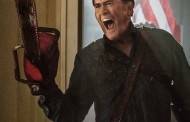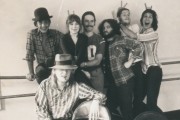 From the moment you meet her, Ana Lily Amirpour seems like a person you want to just hang out with. There’s an energy to her that you rarely see in people; a happy-go-lucky sensibility that puts a smile on your face and makes you want to dance. As a result, our conversation evolved from simply talking about the film (check out my review here) to chatting about other mediums of storytelling and the Sundance experience.
From the moment you meet her, Ana Lily Amirpour seems like a person you want to just hang out with. There’s an energy to her that you rarely see in people; a happy-go-lucky sensibility that puts a smile on your face and makes you want to dance. As a result, our conversation evolved from simply talking about the film (check out my review here) to chatting about other mediums of storytelling and the Sundance experience.
NOTE: This interview occurred immediately after a genre panel at the Sundance Filmmaker lounge, which Ms. Amirpour participated in. References are made to comments she said during the panel. The comic book tie-in to A Girl Who Walks Home Alone at Night is also mentioned, as well as the promotional materials given out during Sundance ( an issue of the comic and a button).
Movie Buzzers: And we are on!
Ana Lily Amirpour: Uh-oh. Woo! Who do we write for?
MB: Moviebuzzers.com
Amirpour: Cool.
MB: The first thing I’m curious about is since you did a lot of different things before filmmaking, like sculpting and music, how did those shape the way you see and make films?
Amirpour: Um, probably it’s just like a big conglomerate of what that is because, I guess a movie is like all the arts in one. You have the visual, what you look at, you have the three dimensions, you have human interaction, you have music, you have sound, you’re writing, it’s everything, really. It’s like the cultural medium of our times. ‘Cus I remember in art school, with painting and sculpting, it’s like, I always felt there was something kind of dead about it. At the same time, while I liked it and I could do it, I just felt like something was…dead, like maybe in Picasso’s time, it was different, and it felt probably more vital and alive. But I needed, I wanted, more, so…
MB: Like it was too static?
Armipour: Yeah, it’s just, it’s not…it’s not the medium of our time. Like, we globally, culturally interact and communicate through movies and through television and that’s, through Youtube, how we understand each other in the world.
MB: Another thing I thought was interesting was when you did the vampire bite, most times it’s much softer—even if it’s an attack, it’s more like a hickey or a little bite. You did—When I saw it, I thought of a Cobra, y’know?
Amirpour: She was pretty like worked up, yeah. So I think there was a little bit of like, she really wanted to let him have it.
MB: Were you looking at it from an emotional perspective, or more of a purely animal perspective?
Amirpour: Well, I don’t know how…do you think that when she killed him, she was doing it for a reason?
MB: I think…My attitude towards her changed—because the first 15 minutes or so, I didn’t want her to talk. Because it seemed to me she was much more a force of nature. And then once the layers were peeled back on her, she became, a still great character, a different kind of character. So I think the first time it’s a meld of she has enough of humanity to try to seek justice, but once she knows she’s gonna kill someone, she’ll just let the animal take over.
Amirpour: That sounds totally right. [Laughs] Yeah! That sounds great!
MB: Now does that lead to the graphic novel? Is that [the mysteriousness of the Girl] part of the reason you did it? To try to fill in the blanks?
Armipour: Y’know, the reason I did it is because, when I wrote the script I had… when I write something I have to, for myself and for my cast, answer all the questions about who each character is—and not just for the vampire, for all the characters. I know their whole life story and history. So, when you have a vampire, that’s like 200 years of stories. So I had all that when I saw the Girl. And it basically became—and it was awesome—I suddenly had this whole universe and this whole history and I was like “Oh what do I wanna—I don’t wanna just not use this, I want to do something with this.” And so, and I always wanted to do a graphic novel, my background was in painting, illustration, and I grew up loving graphic novels, like Crum and Black Hole, just very cerebral, movie graphic novels. But they’re hard to make. They’re hard to get made. It’s like a lot of artwork and a lot of time, it’s very laborious. It is also kind of, in a way, an outdated art form, but I still really wanted to do it. So, when I was making the movie, some of my partners that were involved in the movie, when they heard that I wanted to do it, they were like “well, we want to do this with you”. So, I got really lucky. We partnered, we have this awesome artist in New York who, we got this vision and this look and style, and I get to use all the stories.
MB: It looks beautiful.
Armipour: I love it. I’m so stoked on it.
MB: Is there a release date for the rest of it?
Armipour: Well, we’re putting out…I don’t know how it’s gonna go…we’re heading towards Comic-Con, in June or July—
MB: In San Diego?
Armipour: Yeah. So I think we’ll have the whole book—I don’t know how many issues would be there. But we’ll definitely have a few more issues out. Two and three are in the works right now and almost done.
MB: I’m also a big comic fan too so, it caught my interest.
Armipour: What kind of comics do you like?
MB: I’m reading more mainstream traditional stuff, I’m trying to branch out a bit more, but I was looking at it, what surprised me about the comic was how decompressed it was. I wasn’t expecting that and it seemed to me almost like a film, like storyboards. Not even like panels, but with one page you got the image, what the image stood for emotionally, and that was all you needed.
Armipour: Have you ever seen Charles Burns Black Hole?
MB: No I haven’t.
Armipour: It’s really like, there’s a slow pace to it, and it’s really kind of internal almost, so, as opposed to action. So I’m really into his kind of…pace. Almost like a—I think Frank Miller has that too, almost like a very internal, and you just kinda get sucked into it…the tone.
MB: And that defines the story.
Armipour: Yeah.
MB: You mentioned during the panel that the ending changed. Which surprised me, because I thought the ending in the film was very natural.
Armipour: Not the ending. The end, what you saw, was always the end. There was something that happened in the third act that got removed to allow the ending to be much more simple and refined.
MB: You mind saying what it was?
Armipour: I’m not saying what it was. [Laughs] No one will ever know what it was!
MB: A question about the promotion. You used a comic, as well as a button, which no one else has done. Was that just done from a demographic perspective, or due to your own tastes?
Armipour: They wanted to make buttons and stuff…I mean the poster we were gonna make, that’s our movie poster, and then…it’s like cool and so fun, and cheap to make buttons. You know people hand out postcards with the screening times? I didn’t want to do that. It’s like, all the screenings get sold out anyways, you go the movies. If I was gonna hand anything out it would be the comic, because that’s what I love and what I want people to have.
MB: And also, there’s a different type of feel to it.
Armipour: Yeah. It’s fun.
MB: That’s basically all my questions.
Armipour: Really?
MB: I can ask you more if you want.
Armipour: That was so easy!
MB: You thought I’d ask tough ones? No.
Armipour: It was super chill.
MB: Actually, just thought of another one. It’s about the nature of, not that there’s no dialogue, but since [the film] was so driven by the music, and by the silence. So as a capper, you mentioned dance: what does that mean to you? Do you look at them all as the same thing, the way there’s movement?
Armipour: Yeah you mean why there’s less dialogue and why it’s more place and physical time?
MB: Yeah, the story’s being told through the silence, and lack of silence.
A: Yeah, I think that like Lynch does that sometimes too, and Sergio Leone for sure, and I just personally, I’m really drawn to—I love Tarantino too, and that’s all talking, and it’s great to hear his characters talk, but like, I’m really into finding a way to show things rather than just tell things. And people, I feel like in life, we don’t always explain everything that’s happening. We’re there doing things and seeing things, so there’s a very internal—plus the film and these characters are all really lonely and there’s like a loneliness that’s very internal and quiet in people, and I think that’s stuff that I think about. I mean we even got to places where there had been lines, and we’re editing and we can just cut them out, because…you see it, you get it, you know? In this case, I didn’t feel the words were giving as much of the feeling. Which screening were you at?
MB: I was at Tuesday’s.
Armipour: That was my favorite one.
MB: That was the one where you asked people to dance.
Armipour: Yeah. I love the Egyptian. It’s like the romantic Sundance experience.
MB: It’s one of the last ones I was in as a theater, and the other ones were just normal or average, and I go into the Egyptian and I think this is the first one—this is really what it’s about. It had this aura to it.
Armipour: Yeah, I felt that too. The Prospector was great, we had a great screening, but when we were in the Egyptian I was like “whoa”. And actually, the resort was cool too, because it was this warm, really nice room. They’re all so different. It’s like the vibe of the room—you don’t know what it’s gonna be. It’s interesting.
MB: Thank you very much.
Armipour: My pleasure. So cool talking to you. I’m glad it worked out! Super rad.













Recent Comments